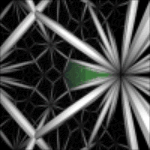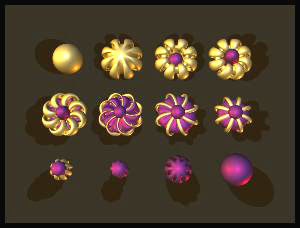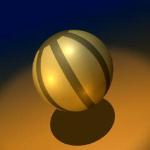The complement of a knot (or link) is the space around it, the part that's not a knot, thus providing us with a title to the video. (Strictly speaking, we should have called the video "Not Link", but it doesn't have much of a ring to it.) It turns out that studying the spaces around knots is also a way of telling whether they are equivalent. We make the assumption that our familiar everyday space is euclidean-our world looks that way to us. However, there are other systems, such as spherical and hyperbolic geometries, that are as consistent and "real" as euclidean geometry is to us. (As a matter of fact, there are theories in cosmology that explore the idea that the universe may be not be euclidean after all, but could be spherical or hyperbolic. [Weeks 1985] ) The differences between these geometries is easiest to imagine in the two dimensional case. A euclidean plane is flat and is said to have no curvature. Spherical geometry takes, not surprisingly, the form of a sphere, and is said to have positive curvature. And hyperbolic geometry is shaped like a saddle, and has negative curvature. We can see what curvature means by thinking about the angles of a triangle located in each one of these surfaces. In the euclidean case, the sum of the angles is 180 degrees, on the sphere it is greater than 180 degrees, and on the saddle it is less than 180 degrees. It is apparent that this same object built in each of these geometric systems will look quite different from one another. Structure of Not KnotIn the video, we use these concepts (and quite a few others not mentioned here) to show how to introduce a hyperbolic structure on the complement of the Borromean rings. In order to build up the viewer's understanding, many simpler situations are shown. We color-coded the objects in the video, so that it is easier to track them throughout the process. (But is must be noted that, even with this thread to follow, the video shows extremely advanced ideas, and it is not expected for viewers to understand everything in it. It is actually used as a study guide in university level math classes.) The Not Knot supplement [Epstein and Gunn 1991] summarizes the video structure this way: "We talk about the aim of putting a structure on the space, so that the knot becomes infinitely far away. Then we turn to a point in a disk, and show how that can be pushed infinitely far away. Next we push a single axis in three-space infinitely far away. Finally we do the same thing for the Borromean rings, pushing all three rings to infinity at the same time." We also introduce the idea of the view of the insider and the outsider-what would someone living inside these spaces actually see? [Abbot 1884]. The final fly-through of hyperbolic space give us just such a glimpse into this space, one where apparent distances seem exaggerated, where a dodecahedron has 90 degree angles between every pair of adjacent faces, and where straight beams appear curved. |




 1
1 2
2  3
3 4
4 5
5 6
6 7
7 8
8 9
9